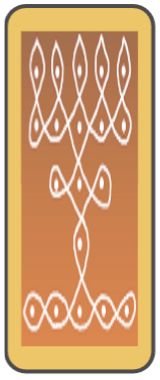 | We learn about........ | |
We have so far learned in this module……
The goal of this lesson is to learn …..
The Classroom Sambashanam Video refreshes our memory on singular and plural verb forms in present tense. We also learn few question forms. Please watch the first half of the video
| Conversation Practice - सम्भाषणाभ्यासः | |
|---|---|
| कति – How many? | |
| कति पुस्तकानि सन्ति? | कति अङ्कन्यः सन्ति? |
| कति पर्णानि सन्ति? | कति चमसाः सन्ति? |
| वर्षे कति मासाः सन्ति? | मासे कति दिनानि सन्ति? |
| पक्षे कति दिनानि सन्ति? | How many days are there in a fortnight? |
| कुत्र? – Where? | |
| दण्डः कुत्र अस्ति? | दण्डः हस्ते अस्ति। दण्डः आसन्दे अस्ति। |
| धनं कुत्र अस्ति? | धनं स्यूते अस्ति। धनं कोषे अस्ति। |
| वार्ता कुत्र अस्ति? | वार्ता पत्रिकायाम् अस्ति। |
| फलं कुत्र अस्ति? | फलं स्थालिकायाम् अस्ति। |
| जलं कुत्र अस्ति? | जलं कूप्याम् अस्ति। |
| अङ्गुल्यकं कुत्र अस्ति? | अङ्गुल्यकं अङ्गुल्याम् अस्ति। |
Let us look at some simple English Sentences.
In the first sentence the benefit of action goes to the doer, while in the second the beneficiary is different from the doer. We normally see different verbs are used to indicate such actions in English. In Samskrit, the verb form used to indicate the Causative action (as in the second example given above) is derived from the direct verb form by adding a prefix called ‘णिच्’. This lesson is intended for primary level learners and hence does not go deep into the grammatic aspects. Instead, we learn to form the causative verb forms using some simple patterns.

The following pictures Explain the role of some of णिजन्त-क्रियापदानि.
 |  |
| छात्रः पाठं पठति। | अध्यापकः पाठं पाठयति। |
 |  |
| बालकः खादति। | जननी पुत्रं खादयति। |
 |  |
| बालकः निद्राति। | माता बालकं निद्रापयति। |
We have a rough pictorial representation that explains the making of Causative verb form from Non causative forms.

Let us now learn Causative verb forms of some present tense forms which we have so far learned. We have grouped the verbs with similar forms.
| सामान्य-रूपम् | णिजन्त-रूपम् |
|---|---|
| Type – I | |
| हसति - Laughs | हासयति – Makes someone laugh |
| हसति - Moves | चालयति – Drives |
| धरति – Holds, Seizes | धारयति – Wears |
| नयति – Brings, Moves | नाययति – Causes to bring/to move |
| करोति – Does | कारयति – Makes others do |
| वदति – Speaks | वादयति – Causes to speak, Plays a musical instrument |
| स्मरति – Thinks, Feels | स्मारयति – Reminds |
| Type – II | |
| कर्षति - Ploughs | कर्षयति – Causes to plough |
| पश्यति - Sees | दर्शयति - Shows |
| गच्छति - Goes | गमयति - Sends |
| Type – III | |
| लिखति - Writes | लेखयति – Makes someone write |
| क्षिपति - Throws | क्षेपयति – Causes to throw |
| प्रविशति - Enters | प्रवेशयति – Lets in |
| Type – IV | |
| कुप्यति – Getting Angry | कोपयति – Causing someone angry |
| तुष्यति – Be satisfied | तोषयति – Pleases/satisfies some one |
| Type – V | |
| गायति - Sings | गापयति – Causes to sing |
| ददाति - Gives | दापयति – Makes someone give |
| पिबति - Drinks | पाययति – Causes to drink |
| तिष्ठति - Stands | स्थापयति - Places |
| स्नाति – Bathes (Self) | स्नापयति – Bathes someone |
| जानाति - Knows | ज्ञापयति – Reminds |
| Type – VI आत्मनेपदी-घातवः | |
| वर्धते – Rises/Grows up | वर्धयति – Raises/Expands |
| भुङ्क्ते - Eats | भोजयति - Feeds |
| बुध्यते - Understands | बोधयति - Teaches |
For Causative purpose, Atmanepadi Dhatus also assume Parasmeipadi endings.
We are not going deep into the Grammatical steps of forming णिजन्त-क्रियापदानि. We will be working more in detail on these in the next module. Let us now learn few example sentences formed with णिजन्त-क्रियापदानि.
| णिजन्त-उदाहरणानि (वाक्यानि) |
|---|
| गुरुः रामायणं बोधयति। Guru teaches Ramayana. |
| स्वामि कार्यं कारयति। Master gets the work done. |
| अहं कवितां श्रावयामि। I recite a poetry |
| अध्यापकः छात्रेन पाठं लेखयति। Teacher makes the student write the lesson. |
एकं लघु अभ्यासं कृत्वा पाठं समापयामः। Let us complete the lesson with some simple practice.
पिबामि
उत्तमपुरुषः एकवचनम्
णिजन्त-रूपम् – पाययामि
We welcome your views and suggestions on this lesson. Please post your comments and replies after registering. Please also send a mail to samskrit@samskritaveethy.com for any clarification on the lesson.
We have so far learned....
You read.
You go to School.
Please take your food.
Let me drive the car.
How can we say sentences which sound like an order, request or intention? Our next lesson teaches us how to write the verb forms for such situations.
Lesson 9: Sanskrit Verb Forms Imperative Mood - आज्ञाप्रार्थनादिषु लोट्
 | 0 comments |
To get updates on
संस्कृतवीथी...